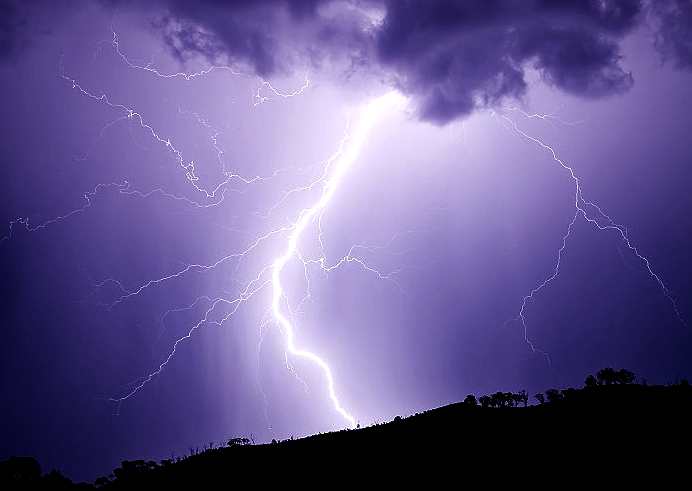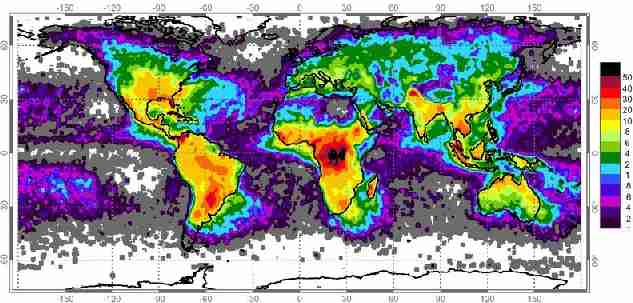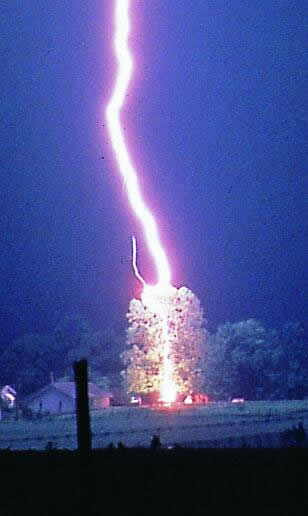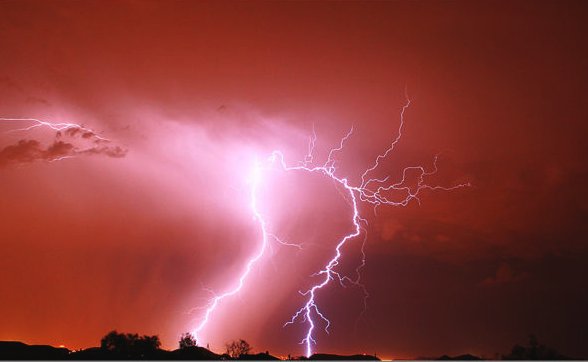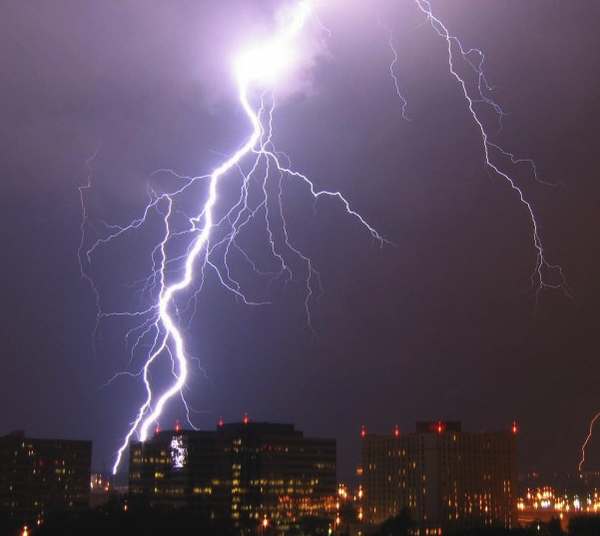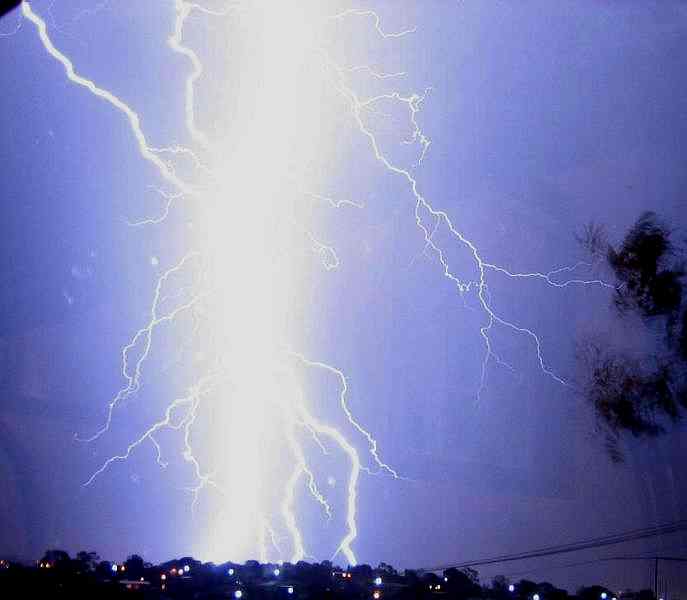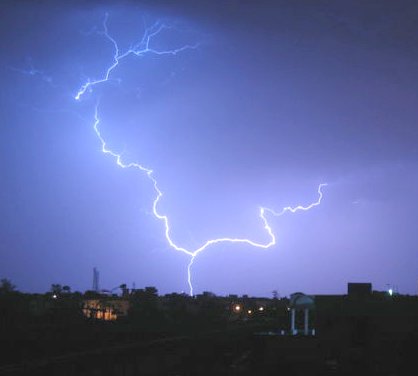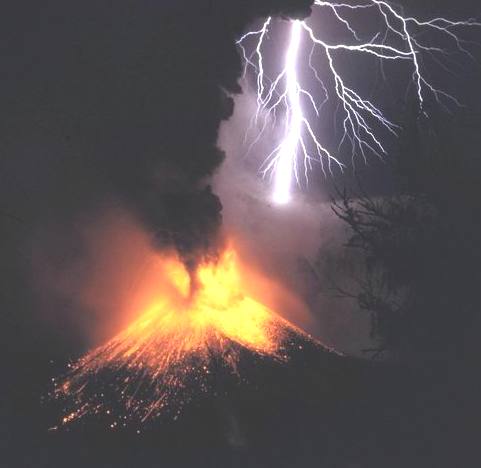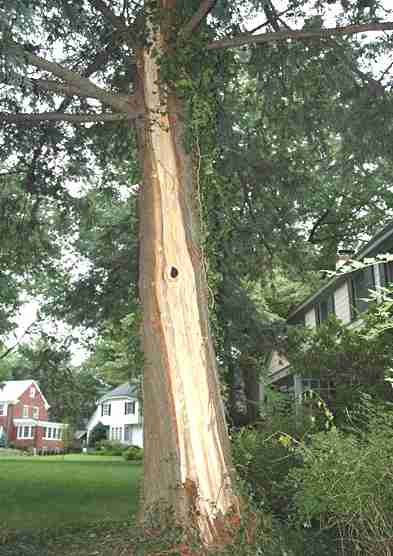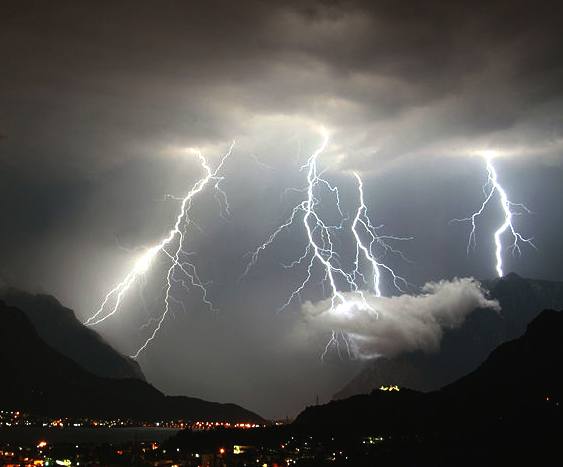|
LIGHTNING
|
||||||||
|
Lightning is more than just an atmospheric discharge of electricity, if you are lucky enough to experience one, it is a beautiful example of the power of nature. Theywhich typically occurs during thunderstorms, and sometimes during volcanic eruptions or dust storms.
Lightning strike January 2007
History and research
Beginnings
In his Dream Pool Essays of 1088 AD, the Song Dynasty polymath Chinese scientist Shen Kuo (1031-1095) wrote of the natural phenomenon of lightning. When a house belonging to one Li Shunju had been struck by lightning, Kuo wrote that everyone assumed that the house would be burnt to the ground. To everyone's surprise, some of the wooden walls were merely blackened and lacquerwares untouched, while metal objects such as a steel sword were melted into liquid. Kuo compared this phenomena to the equally strange effects of water being unable to douse Greek fire (which had been known to the Chinese since the Arabs had traded it, or a chemical composition fairly equal to it, in the 10th century). For these strange effects of lightning, Kuo wrote:
Thus was the frustration of learned men in his time of the desire to know the true nature of lightning and other such common phenomena. However, in the Western world the true nature and understanding behind its force would become known by the 18th century.
Benjamin Franklin (1706-1790) endeavored to test the theory that sparks shared some similarity with lightning using a spire which was being erected in Philadelphia. While waiting for completion of the spire, he got the idea of using a flying object, such as a kite, instead. During the next thunderstorm, which was in June 1752, it was reported that he raised a kite, accompanied by his son as an assistant. On his end of the string he attached a key and tied it to a post with a silk thread. As time passed, Franklin noticed the loose fibres on the string stretching out; he then brought his hand close to the key and a spark jumped the gap. The rain which had fallen during the storm had soaked the line and made it conductive.
Franklin was not the first to perform the kite experiment. Thomas-François Dalibard and De Lors conducted it at Marly-la-Ville in France a few weeks before Franklin's experiment. In his autobiography (written 1771-1788, first published 1790), Franklin clearly states that he performed this experiment after those in France, which occurred weeks before his own experiment, without his prior knowledge as of 1752. According to author Tom Tucker, Franklin never actually performed the famed kite experiment, but rather published his account of it as a hoax, possibly to endanger his detractors.
Continuing research
As news of the experiment and its particulars spread, people attempted to replicate it. However, experiments involving lightning are always risky and frequently fatal. The most well-known death during the spate of Franklin imitators was that of Professor George Richmann, of Saint Petersburg, Russia. He had created a set-up similar to Franklin's, and was attending a meeting of the Academy of Sciences when he heard thunder. He ran home with his engraver to capture the event for posterity. While the experiment was under way, ball lightning appeared, collided with Richmann's head and killed him, leaving a red spot. His shoes were blown open, parts of his clothes singed, the engraver knocked out, the door frame of the room split, and the door itself torn off its hinges.
Although experiments from the time of Franklin showed that lightning was a discharge of static electricity, there was little improvement in theoretical understanding of lightning (in particular how it was generated) for more than 150 years. The impetus for new research came from the field of power engineering: as power transmission lines came into service, engineers needed to know much more about lightning in order to adequately protect lines and equipment.
World map showing frequency of lightning strikes, in flashes per km² per year. Lightning strikes most frequently in the Democratic Republic of the Congo
Properties of lightning
A bolt of lightning can travel at a speed of 45 km/s (100,000 mph, 160,000 km/h). It can reach temperatures approaching 28,000 °C (50,000 °F), hot enough to fuse soil or sand into glass channels.
An average bolt of lightning carries a negative electric current of 40 kA, although some bolts can be up to 120 kA, and transfers a charge of five coulombs and 500 MJ, or enough energy to power a 100 watt lightbulb for just under two months. The voltage depends on the length of the bolt: with the dielectric breakdown of air being three million volts per meter, this works out at about one billion (thousand million) volts for a 300m (1,000 foot) lightning bolt. With an electric current of 100 kA, this gives a power of 100 trillion (million million) watts.
Different locations have different potentials (voltages) and currents for an average lightning strike. For example, Florida, with the United States' largest number of recorded strikes in a given period during the summer season, has very sandy ground in some areas and conductive saturated mucky soil in others. As much of Florida lies on a peninsula, it is bordered by the ocean on three sides. The end result is the daily development of sea and lake breeze boundaries that collide and produce thunderstorms. Arizona, which has very dry, sandy soil and a very dry air, has cloud bases as high as 1800-2100 m (6,000-7,000 feet) above ground level, and gets very long and thin purplish discharges which crackle; while Oklahoma, with cloud bases about 450-600 m (1,500-2,000 feet) above ground level and fairly soft, clay-rich soil, has big, blue-white explosive lightning strikes that are very hot (high current) and cause sudden, explosive noise when the discharge comes. The difference in each case may consist of differences in voltage levels between clouds and ground. Research on this is still ongoing.
NASA scientists have also found the radio waves created by lightning clear a safe zone in the radiation belt surrounding the earth. This zone, known as the Van Allen Belt slot, can potentially be a safe haven for satellites, offering them protection from the Sun's radiation.
The first process in the generation of lightning is still a matter of debate: scientists have studied root causes ranging from atmospheric perturbations (wind, humidity, and atmospheric pressure), to the impact of solar wind and accumulation of charged solar particles. Large quantities of ice in the clouds are suspected to enhance lightning development. This charge will neutralize itself through any available path. This may assist in the forcible separation of positive and negative charge carriers within a cloud or air, and thus help in the formation of lightning.
Lightning can also occur within the ash clouds from volcanic eruptions, or can be caused by violent forest fires which generate sufficient dust to create a static charge.
Lightning striking a tree
Formation
Note
Charge separation
The first process in the generation of lightning is charge separation.
Polarization mechanism theory
The mechanism by which charge separation happens is still the subject of research, but one theory is the polarization mechanism, which has two components:
Electrostatic induction theory
Another theory is that opposite charges are driven apart by the above mechanism and energy is stored in the electric field between them. Cloud electrification appears to require strong updrafts which carry water droplets upward, supercooling them to -10 to -20 C. These collide with ice crystals to form a soft ice-water mixture called graupel. The collisions result in a slight positive charge being transferred to ice crystals, and a slight negative charge to the graupel. Updrafts drive lighter ice crystals upwards, causing the cloud top to accumulate increasing positive charge. The heavier negatively charged graupel falls towards the middle and lower portions of the cloud, building up an increasing negative charge. Charge separation and accumulation continue until the electrical potential becomes sufficient to initiate lightning discharges, which occurs when the gathering of positive and negative charges forms a sufficiently strong electric field.
There are several additional theories for the origin of charge separation.
Leader formation
As a thundercloud moves over the Earth's surface, an equal but opposite charge is induced in the Earth below, and the induced ground charge follows the movement of the cloud.
An initial bipolar discharge, or path of ionized air, starts from a negatively charged mixed water and ice region in the thundercloud. The discharge ionized channels are called leaders. The negative charged leaders, called a "stepped leader", proceed generally downward in a number of quick jumps, each up to 50 meters long. Along the way, the stepped leader may branch into a number of paths as it continues to descend. The progression of stepped leaders takes a comparatively long time (hundreds of milliseconds) to approach the ground. This initial phase involves a relatively small electric current (tens or hundreds of amperes), and the leader is almost invisible compared to the subsequent lightning channel.
When a stepped leader approaches the ground, the presence of opposite charges on the ground enhances the electric field. The electric field is highest on trees and tall buildings. If the electric field is strong enough, a conductive discharge (called a positive streamer) can develop from these points. This was first theorized by Heinz Kasemir. As the field increases, the positive streamer may evolve into a hotter, higher current leader which eventually connects to the descending stepped leader from the cloud. It is also possible for many streamers to develop from many different objects simultaneously, with only one connecting with the leader and forming the main discharge path. Photographs have been taken on which non-connected streamers are clearly visible. When the two leaders meet, the electric current greatly increases. The region of high current propagates back up the positive stepped leader into the cloud with a "return stroke" that is the most luminous part of the lightning discharge.
Discharge
When the electric field becomes strong enough, an electrical discharge (the bolt of lightning) occurs within clouds or between clouds and the ground. During the strike, successive portions of air become a conductive discharge channel as the electrons and positive ions of air molecules are pulled away from each other and forced to flow in opposite directions.
The electrical discharge rapidly superheats the discharge channel, causing the air to expand rapidly and produce a shock wave heard as thunder. The rolling and gradually dissipating rumble of thunder is caused by the time delay of sound coming from different portions of a long stroke.
Gurevich's cosmic ray theory
A theory proposed by Alex Gurevich of the Lebedev Physical Institute in 1992 suggests that lightning strikes are triggered by cosmic rays which ionize atoms, releasing electrons that are accelerated by the electric fields, ionizing other air molecules and making the air conductive by a runaway breakdown, then starting a lightning strike.
Lightning illuminates the night sky red
Gamma rays and the runaway breakdown theory
It has been discovered in the past 15 years that among the processes of lightning is some mechanism capable of generating gamma rays, which escape the atmosphere and are observed by orbiting spacecraft. Brought to light by NASA's Gerald Fishman in 1994 in an article in Nature, these so-called Terrestrial Gamma-Ray Flashes (TGFs) were observed by accident, while he was documenting instances of extraterrestrial gamma ray bursts observed by the Compton Gamma Ray Observatory (CGRO). TGFs are much shorter in duration, however, lasting only ~1 ms.
Professor Umran Inan of Stanford linked a TGF to an individual lightning stroke occurring within 1.5 ms of the TGF event, proving for the first time that the TGF was of atmospheric origin and associated with lightning strikes.
CGRO recorded only about 77 events in 10 years, however more recently, the RHESSI spacecraft, as reported by David Smith of UC Santa Cruz, has been observing TGFs at a much higher rate, indicating that these occur ~50 times per day globally (still a very small fraction of the total lightning on the planet). The energy levels recorded exceed 20 MeV.
Scientists from Duke University have also been studying the link between certain lightning events and the mysterious gamma ray emissions that emanate from the Earth's own atmosphere, in light of newer observations of TGFs made by RHESSI. Their study suggests that this gamma radiation fountains upward from starting points at surprisingly low altitudes in thunderclouds.
Steven Cummer, from Duke University's Pratt School of Engineering, said, "These are higher energy gamma rays than come from the sun. And yet here they are coming from the kind of terrestrial thunderstorm that we see here all the time."
Early theories of this pointed to lightning generating high electric fields at altitudes well above the cloud, where the thin atmosphere allows gamma rays to easily escape into space, known as "relativistic runaway breakdown", similar to the way sprites are generated. Subsequent evidence has cast doubt, though, and suggested instead that TGFs may be produced at the tops of high thunderclouds. Though hindered by atmospheric absorption of the escaping gamma rays, these theories do not require the exceptionally high electric fields that high altitude theories of TGF generation rely on.
The role of TGFs and their relationship to lightning remains a subject of ongoing scientific study.
Lightning is a highly visible form of energy transfer
Re-strike
High speed videos (examined frame-by frame) show that most lightning strikes are made up of multiple individual strokes. A typical strike is made of 3 to 4 strokes. There may be more.
Each re-strike is separated by a relatively large amount of time, typically 40 to 50 milliseconds. Re-strikes can cause a noticeable "strobe light" effect.
Each successive stroke is preceded by intermediate dart leader strokes akin to, but weaker than, the initial stepped leader. The stroke usually re-uses the discharge channel taken by the previous stroke.
The variations in successive discharges are the result of smaller regions of charge within the cloud being depleted by successive strokes.
The sound of thunder from a lightning strike is prolonged by successive strokes.
Types of lightning
Some lightning strikes take on particular characteristics; scientists and the public have given names to these various types of lightning. Most lightning is streak lightning. This is nothing more than the return stroke, the visible part of the lightning stroke. Because most of these strokes occur inside a cloud, we do not see many of the individual return strokes in a thunderstorm.
Cloud-to-cloud
Lightning discharges may occur between areas of cloud having different potentials without contacting the ground. These are most common between the anvil and lower reaches of a given thunderstorm. This lightning can sometimes be observed at great distances at night as so-called "heat lightning". In such instances, the observer may see only a flash of light without thunder. The "heat" portion of the term is a folk association between locally-experienced warmth and the distant lightning flashes.
Dry lightning
Dry lightning is a folk misnomer in common usage in the United States for thunderstorms which produce no precipitation at the surface. This type of lightning is the most common natural cause of wildland fires.
Rocket Lightning, Queanbeyan, Australia
Rocket lightning
It is a form of cloud discharge, generally horizontal and at cloud base, with a luminous channel appearing to advance through the air with visually resolvable speed, often intermittently.
The movement resembles the movement of a rocket, hence its name. It is also one of the rarest of cloud discharges.
Cloud-to-ground
Cloud-to-ground lightning is a great lightning discharge between a cumulonimbus cloud and the ground initiated by the downward-moving leader stroke. This is the second most common type of lightning, and poses the greatest threat to life and property of all known types.
Bead lightning
Bead lightning is a type of cloud-to-ground lightning which appears to break up into a string of short, bright sections, which last longer than the usual discharge channel. It is fairly rare. Several theories have been proposed to explain it. One is that the observer sees portions of the lightning channel end on, and that these portions appear especially bright. Another is that, in bead lighting, the width of the lightning channel varies; as the lightning channel cools and fades, the wider sections cool more slowly and remain visible longer, appearing as a string of beads.
Ribbon lightning
Ribbon lightning occurs in thunderstorms with high cross winds and multiple return strokes. The wind will blow each successive return stroke slightly to one side of the previous return stroke, causing a ribbon effect.
Staccato lightning
Staccato lightning, which is nothing more than a leader stroke with only one return stroke.
Positive lightning
Positive lightning, also known colloquially as a "bolt from the blue" makes up less than 5% of all lightning. It occurs when the leader forms at the positively charged cloud tops, with the consequence that a negatively charged streamer issues from the ground. The overall effect is a discharge of positive charges to the ground. Research carried out after the discovery of positive lightning in the 1970s showed that positive lightning bolts are typically six to ten times more powerful than negative bolts, last around ten times longer, and can strike tens of kilometres/miles from the clouds. The voltage difference for positive lightning must be considerably higher, due to the tens of thousands of additional metres/feet the strike must travel. During a positive lightning strike, huge quantities of ELF and VLF radio waves are generated.
As a result of their greater power, positive lightning strikes are considerably more dangerous. At the present time, aircraft are not designed to withstand such strikes, since their existence was unknown at the time standards were set, and the dangers unappreciated until the destruction of a glider in 1999.
Positive lightning is also now believed to have been responsible for the 1963 in-flight explosion and subsequent crash of Pan Am Flight 214, a Boeing 707. Subsequently, aircraft operating in U.S. airspace have been required to have lightning discharge wicks to reduce the chances of a similar occurrence.
Positive lightning has also been shown to trigger the occurrence of upper atmosphere lightning. It tends to occur more frequently in winter storms and at the end of a thunderstorm.
An average bolt of positive lightning carries a current of up to 300 kA (kiloamperes) (about ten times as much current as a bolt of negative lightning), transfers a charge of up to 300 coulombs, has a potential difference up to 1 GV (gigavolts), and lasts for hundreds of milliseconds, with a discharge energy of up to 300 GJ (gigajoules).
Anvil-to-ground
One special type of cloud-to-ground lightning is anvil-to-ground lightning. It is a form of positive lightning, since it emanates from the anvil top of a cumulonimbus cloud where the ice crystals are positively charged. The leader stroke issues forth in a nearly horizontal direction until it veers toward the ground. These usually occur kilometers/miles from (often ahead) of the main storm and will sometimes strike without warning on a sunny day. An anvil-to-ground lightning bolt is a sign of an approaching storm, and if one occurs in a largely clear sky, it is known colloquially as a "Bolt from the blue"
Probable cloud-to-ground lightning, but difficult to distinguish from ground-to-cloud by visual inspection
Ground-to-cloud lightning
Ground-to-cloud lightning is a lightning discharge between the ground and a cumulonimbus cloud from an upward-moving leader stroke.
Ball lightning
Ball lightning is described as a floating, illuminated ball that occurs during thunderstorms. They can be fast moving, slow moving or nearly stationary. Some make hissing or crackling noises or no noise at all. Some have been known to pass through windows and even dissipate with a bang. Ball lightning has been described by eyewitnesses but rarely recorded by meteorologists.
The engineer Nikola Tesla wrote, "I have succeeded in determining the mode of their formation and producing them artificially". There is some speculation that electrical breakdown and arcing of cotton and gutta-percha wire insulation used by Tesla may have been a contributing factor, since some theories of ball lightning require the involvement of carbonaceous materials. Some later experimenters have been able to briefly produce small luminous balls by igniting carbon-containing materials atop sparking Tesla Coils.
Several theories have been advanced to describe ball lightning, with none being universally accepted. Any complete theory of ball lightning must be able to describe the wide range of reported properties, such as those described in Singer's book "The Nature of Ball Lightning" and also more contemporary research. Japanese research shows that ball lightning has been seen several times without any connection to stormy weather or lightning.
Ball lightning is typically 20 – 30 cm (8-12 inches) in diameter, but ball lightning several meters in diameter has been reported. Ball lightning has been seen in tornadoes, and has also been seen to split apart into two or more separate balls and recombine, and vertically-linked fireballs have been reported. Ball lightning has carved trenches in the peat swamps in Ireland. Because of its strange behavior, ball lightning has been mistaken for a UFO by many witnesses. One theory that may account for this wider spectrum of observational evidence is the idea of combustion inside the low-velocity region of axisymmetric (spherical) vortex breakdown of a natural vortex (e.g., the 'Hill's spherical vortex').
Upper-atmospheric
Reports by scientists of strange lightning phenomena above storms date back to at least 1886. However, it is only in recent years that fuller investigations have been made. This has sometimes been called megalightning.
Sprites
Sprites are now well-documented electrical discharges that occur high above some types of thunderstorms. They appear as luminous reddish-orange, plasma-like flashes, last longer than normal lower stratospheric discharges (typically around 17 milliseconds), and are triggered by the discharges of positive lightning between the thundercloud and the ground. Sprites often occur in clusters of two or more, and typically span the distance from 50 to 90 km (30 to 55 miles) above the earth, with what appear to be tendrils hanging below and branches reaching above. A 2007 paper reports that the apparent tendrils and branches of sprites are actually formed by bright streamer heads of less than 140 m diameter moving up or down at 1 to 10 percent of the speed of light.
Sprites may be horizontally displaced by up to 50 km (30 miles) from the location of the underlying lightning strike, with a time delay following the lightning that is typically a few milliseconds, but on rare occasions may be up to 100 milliseconds. Sprites are sometimes, but not always, preceded by a sprite halo, a broad, pancake-like region of transient optical emission centered at an altitude of about 75 km above lightning. Sprite halos are produced by weak ionization from transient electric fields of the same type that causes sprites, but which are insufficiently intense to exceed the threshold needed for sprites. Sprites were first photographed on July 6, 1989, by scientists from the University of Minnesota and named after the mischievous sprite (air spirit) Ariel in Shakespeare's "The Tempest".
Recent research carried out at the University of Houston in 2002 indicates that some normal (negative) lightning discharges produce a sprite halo, the precursor of a sprite, and that every lightning bolt between cloud and ground attempts to produce a sprite or a sprite halo. Research in 2004 by scientists from Tohoku University found that very low frequency emissions occur at the same time as the sprite, indicating that a discharge within the cloud may generate the sprites.
Blue jets
Blue jets differ from sprites in that they project from the top of the cumulonimbus above a thunderstorm, typically in a narrow cone, to the lowest levels of the ionosphere 40 to 50 km (25 to 30 miles) above the earth. They are also brighter than sprites and, as implied by their name, are blue in color. They were first recorded on 21 October 1989, on a video taken from the space shuttle as it passed over Australia, and subsequently extensively documented in 1994 during aircraft research flights by the University of Alaska.
On 14 September 2001, scientists at the Arecibo Observatory photographed a huge jet double the height of those previously observed, reaching around 80 km (50 miles) into the atmosphere. The jet was located above a thunderstorm over the ocean, and lasted under a second. Lightning was initially observed traveling up at around 50,000 m/s in a similar way to a typical blue jet, but then divided in two and sped at 250,000 m/s to the ionosphere, where they spread out in a bright burst of light. On 22 July 2002, five gigantic jets between 60 and 70 km (35 to 45 miles) in length were observed over the South China Sea from Taiwan, reported in Nature. The jets lasted under a second, with shapes likened by the researchers to giant trees and carrots.
Elves
Elves often appear as a dim, flattened, expanding glow around 400 km (250 miles) in diameter that lasts for, typically, just one millisecond. They occur in the ionosphere 100 km (60 miles) above the ground over thunderstorms. Their color was a puzzle for some time, but is now believed to be a red hue. Elves were first recorded on another shuttle mission, this time recorded off French Guiana on October 7, 1990. Elves is a frivolous acronym for Emissions of Light and Very Low Frequency Perturbations From Electromagnetic Pulse Sources. This refers to the process by which the light is generated; the excitation of nitrogen molecules due to electron collisions (the electrons possibly having been energized by the electromagnetic pulse caused by a discharge from the Ionosphere).
Triggered lightning
Rocket-triggered
Lightning has been triggered directly by human activity in several instances. Lightning struck the Apollo 12 soon after takeoff, and has struck soon after thermonuclear explosions. It has also been triggered by launching lightning rockets carrying spools of wire into thunderstorms. The wire unwinds as the rocket climbs, making a convenient path for the lightning to use. These bolts are typically very straight, due to the path created by the wire.
It is also well known in the aeronautics world that flying aircraft often trigger lightning strikes (cloud-to-cloud mostly).
Volcanic material thrust high into the atmosphere can trigger spectacular lightning 1994
Volcanically-triggered
Extremely large volcanic eruptions, which eject gases and solid material high into the atmosphere, can trigger lightning. This phenomenon was documented by Pliny The Elder during the AD79 eruption of Vesuvius, in which he perished.
Laser-triggered
Since at least the 1970s, researchers have attempted to trigger lightning strikes by means of ultra-violet lasers, which create a channel of ionized gas through which the lightning would be conducted to ground. Such triggered lightning is intended to protect rocket launching pads, electric power facilities, and other sensitive targets.
Extraterrestrial lightning
Lightning requires the electrical breakdown of a gas, so it cannot exist in a visual form in the vacuum of space. However, lightning has been observed within the atmospheres of other planets, such as Venus and Jupiter. Lightning on Venus is still a controversial subject after decades of study. During the Soviet Venera and U.S. Pioneer missions of the 1970s and 80s, signals suggesting lightning may be present in the upper atmosphere were detected.
However, recently the Cassini-Huygens mission fly-by of Venus detected no signs of lightning at all.
Lightning damage to tree in Maplewood, NJ USA
Trees and lightning
Trees are frequent conductors of lightning to the ground. Since sap is a poor conductor, its electrical resistance causes it to be heated explosively into steam, which blows off the bark outside the lightning's path. In following seasons trees overgrow the damaged area and may cover it completely, leaving only a vertical scar. If the damage is severe, the tree may not be able to recover, and decay sets in, eventually killing the tree. Occasionally, a tree may explode completely, as in this Giant Sequoia struck in Geneva. It is commonly thought that a tree standing alone is more frequently struck, though in some forested areas, lightning scars can be seen on almost every tree. A frequently struck tree is the Pine. Unlike the Oak which has a relatively shallow root structure the Pine has a deep central root that goes down into the water table. They usually stand taller than other species which also makes them a likely target. In Johannesburg - one of the places with a very high incidence of lightning strikes—the most commonly struck tree is Cedrus deodara, locally known as the Christmas tree. Factors which lead to its being targeted are a high resin content, its loftiness and its needles which lend themselves to a high electrical discharge during a thunderstorm.
Trees are natural lightning conductors and are known to provide protection against lightning damages to the nearby buildings. Tall trees with high biomass for the root system provide good lightning protection. An example is the teak tree (Tectona grandis), which grows to a height of 45 m. It has a spread root system with a spread of 5 m and a biomass of 4 times that of the trunk; its penetration into the soil is 1.25 m and has no tap root. When planted near a building, its height helps in catching the oncoming lightning leader and the high biomass of the root system helps in dissipation of the lightning charges
Lightning currents are characterised by a high rate of change, on the order of 40 kA per microsecond. Hence, conductors of such currents exhibit marked skin effect, causing most of the currents to flow through the conductor skin (Zinnia Nair, Aparna K.M,Khandagale R.S,Gopalan T.V,Failure of 220 kV double circuit transmission line tower due to lightning, ASCE Jl of Performance of Constructed Facilities, Vol.19,No.2,May 1,2005). The effective resistance of the conductor is consequently very high and therefore, the conductor skin gets heated up much more than the conductor core. When a tree acts as a natural lightning conductor, due to skin effect most of the lightning currents flow through the skin of the tree and the sap wood. As a result, the skin gets burnt and may even peel off. The moisture in the skin and the sap wood evaporates instantaneously and may get split. If the tree struck by lightning is a teak tree (single stemmed with branches) it may not be completely destroyed since only the tree skin and a branch may be affected; the major parts of the tree may be saved from complete destruction due to lightning currents. But if the tree involved is a coconut tree it may be completely destroyed by the lightning currents.
Records and locations
On average, lightning strikes the earth about 100 times every second. "Lightning Alley", referring to Interstate 4 between Orlando and St. Petersburg FL, collectively sees more lightning strikes per year than any other place in the US. "Lightning Alley" averages 120 thunderstorm days per year. The Empire State Building is struck by lightning on average 23 times each year, and was once struck 8 times in 24 minutes. Singapore has one of the highest rates of lightning activity in the world. The city of Teresina in northern Brazil has the third-highest rate of occurrences of lightning strikes in the world. The surrounding region is referred to as the Chapada do Corisco ("Flash Lightning Flatlands").
Roy Sullivan held a Guinness World Record after surviving 7 different lightning strikes across 35 years.
In July 2007, lightning killed up to 30 people when it struck a remote mountain village Ushari Dara in northwestern Pakistan. Also, in Deerfield Beach, Florida lightning struck a diver's air tank as he surfaced off Florida's Atlantic coast, killing him. He had surfaced about 10 meters (30 feet) from the boat when lightning struck his tank.
Lightning detection
Lightning discharges generate a wide range of electromagnetic radiations, including radio-frequency pulses. The times at which a pulse from a given lightning discharge arrive at several receivers can be used to locate the source of the discharge. The United States federal government has constructed a nation-wide grid of such lightning detectors, allowing lightning discharges to be tracked in real time throughout the continental U.S.
In addition to ground-based lightning detection, several instruments aboard satellites have been constructed to observe lightning distribution. These include the Optical Transient Detector (OTD) and the subsequent Lightning Imaging Sensor (LIS).
In culture
The expression "lightning never strikes twice [in the same place]" is similar to "opportunity never knocks twice" in the vein of a "once in a lifetime" opportunity, i.e., something that is generally considered improbable. Lightning occurs frequently and more so in specific areas. Since various factors alter the probability of strikes at any given location, repeat lightning strikes have a very low probability (but are not impossible). Similarly, "a bolt from the blue" refers to something totally unexpected.
In French and Italian, the expression for "love at first sight" is coup de foudre and colpo di fulmine, respectively, which literally translated means "bolt of lightning". Some European languages have a separate word for lightning which strikes the ground (as opposed to lightning in general); often it is a cognate of the English word "rays". The name of New Zealand's most celebrated thoroughbred horse, Phar Lap, derives from the shared Zhuang and Thai word for lightning.
The bolt of lightning in heraldry is called a thunderbolt and is shown as a zigzag with non-pointed ends. It is also distinguished from the "fork of lightning". The lightning bolt shape was a symbol of male humans among the Native Americans such as the Apache in the American Old West. Harry Potter, protagonist in the seven-book Harry Potter series authored by J.K. Rowling, has a lightning-bolt shaped scar on his forehead.
LINKS and REFERENCE
STORMS | HURRICANES | TORNADOES | ATMOSPHERE | WATER CYCLE | FORECASTING | FLOODS | LIGHTNING
.. Thirst for Life
330ml Earth can - the World in Your Hands
|
||||||||
|
This website is Copyright © 1999 & 2012 Blueplanet Netdirect Publications. The bird logos and name Solar Navigator are trademarks. All rights reserved. Max Energy Limited is an educational charity. |
||||||||
|
AUTOMOTIVE | BLUEPLANET | ELECTRIC CARS | ELECTRIC CYCLES | SOLAR CARS | SOLARNAVIGATOR | UTOPIA |
